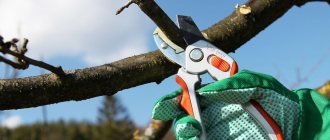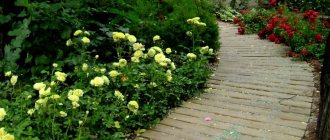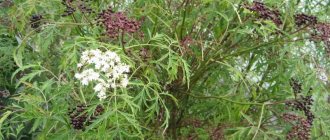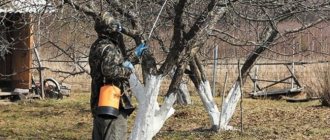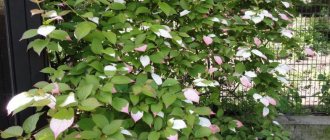What kind of work can be done in the garden in winter, in the vegetable garden, many people who are far from gardening may exclaim questioningly. During this winter season, in our garden plots there is not a living green leaf to be found, either on the trees or on the ground. Everything looks like a dull, monotonous black and white landscape, and in the Kuban gardens you can’t even see white. Winters are now almost snowless. But, despite the fact that all woody fruit plants and berry bushes in the garden plot are immersed in winter sleep, they cannot be ignored. Real gardeners cannot do this. All their actions in winter will be aimed at preparing for the next growing season.
Lawn
Preparing your lawn for winter is quite simple. From mid-autumn, the frequency of watering is gradually reduced, and with the onset of the first frosts, they stop watering altogether. It is very useful to carry out aeration one last time, that is, make punctures in places where the soil is compacted with a special tool or an ordinary pitchfork.
Fertilizing with potassium fertilizers will help the grass cover survive the winter safely. It would be a good idea to free it from weeds using selective herbicides. They continue to mow the lawn until the coldest weather, so that it goes under the snow with a grass height of no more than 7–9 cm. Grass that is too short will freeze, and tall grass will begin to rot under the snow. It is important to guess the time of the last cutting correctly, otherwise the root system weakened by it will not be able to provide the plants with nutrients. In addition, in the cut areas, the grass is especially susceptible to frostbite.
Removing leaves and dead grass is a mandatory procedure for all types of lawns, except meadow and shady ones, which are best combed out in the spring. If the soil is very wet or frozen, and there is no snow yet, walking on the green carpet should be minimized so as not to damage the growth buds at the base of the stems. In winter, the snow on the lawn is loosened from time to time so that it does not become covered with an ice crust.
Security measures
In winter, your dacha can become a target for robbers. To avoid tempting criminals, remove all valuables from your home.
Burglars usually enter the house through windows, so you can install bars or metal shutters on them. If possible, install an alarm and enter into an agreement with a security company.
Herbaceous perennials
Most perennials tolerate even harsh winters well. Their preparation for cold weather mainly comes down to removing the above-ground part of the plant before the leaves completely wither. This will direct all his strength to strengthening the roots.
The hollow stems of plants such as phytolacca, delphiniums, etc., are broken or plugged so that water does not get into them, causing rotting of the root collar. Some experts advise pruning not all perennials, but only those that soften under the influence of frost (hostas, daylilies, etc.).
It is better not to touch plants with hard stems (cereals, wormwood, monarda, solidago), as they hold snow well, preventing the roots from freezing. The soil near the plants is loosened, superphosphate and potassium fertilizers are applied, mulched with dry peat, after which watering and fertilizing are stopped until spring. It is useful to spud some perennials (peonies, chrysanthemums, phlox). Even dahlias that do not overwinter in the ground are planted to a height of 15–17 cm in early September. In the event of early frosts, this will protect the root collars from freezing. And root tubers will withstand winter storage better. They are dug up around mid-October, when night temperatures reach sub-zero temperatures. In this case, they act with extreme caution, since the tubers are very weakly attached to the root collar.
Gladioli bulbs are dug up when their leaves begin to turn yellow. First they deal with early varieties, then middle, late and, finally, grown from children. With tuberous begonia, this operation is carried out after severe frosts. If dahlias, gladioli, begonias, cannas, freesias, hazel grouse, as well as some types of chrysanthemums are removed from the ground for the winter, then daffodils, tulips, hyacinths, garden lilies of the valley and other small-bulbous plants are planted.
Planting is carried out throughout October: they start with small bulbous ones, and from the middle of the month they begin to tulips, which can be worked with in November if the soil has not yet frozen. The easiest way to protect bulbs from mouse teeth is to place them in containers made from ordinary plastic bottles with a perforated bottom. Daffodils don't need such protection because mice don't bother them.
Under synthetic non-woven materials, plants, especially evergreens, suffer from heat. Therefore, it is better to use them only for protection against spring frosts.
Perennials do not need winter shelter, with the exception of recently planted ones growing in open places and ground cover. Over heat-loving cereals, huts are built from spruce branches, tying the stems into loose sheaves. A wire frame filled with dry leaves or thin shavings is installed over anemones, crocosmia, and Korean chrysanthemums, and the top is covered with film. Shelter is contraindicated for perennial asters, bergenia, and heuchera, as they can get in contact with and suffer from a fungal infection.
Aquatic plants that need positive temperatures are transferred to a warm room, planted in pots with “native” soil. The hollow stems of the reed are not completely removed, as they promote air exchange. Experts advise regularly clearing snow from ice in winter so that light can reach underwater plants.
It is better not to use fallen leaves as insulation, as the plants underneath them quickly begin to rot.
Working in the garden takes a lot of time and effort. Modern gardening equipment will help make it easier. So, a garden vacuum cleaner will drive the garbage into a heap with a directed air flow, then collect it in a special bag, and crush the fallen leaves, grass and cut branches using the built-in impeller, reducing it many times in volume and turning it into mulch. On a plot of up to 20 acres, a portable vacuum cleaner will do the job quite well. On larger ones, it is better to use wheeled units, which are produced in both self-propelled and non-self-propelled versions.
Shredders will be useful on the site. They will grind branches, tree bark, leaves, cones, etc. Thanks to the wheels, the device can be easily transported to the place of work.
Walk-behind tractors and motor-cultivators can handle almost any work in the garden. Thanks to special attachments, their functions are very wide. In the fall, for example, they will help plow and loosen the soil, add fertilizers to it, aerate and comb the lawn, hill up plants, and dig holes for planting trees and shrubs. The Russian market today offers both foreign and domestic equipment, which is still inferior to imported ones in terms of the variety of models and attachments for them, as well as quality.
Ornamental shrubs and vines
Shelter of a rose
Of all the beautiful flowering plants, Russians traditionally prefer roses
. That’s why they take care of their safety in the winter first of all. True, the delicacy of these beauties is somewhat exaggerated. Most varieties can withstand frosts of 7-10°C, and frost-resistant ones can withstand even 25-degree cold. They suffer mainly from excess moisture and lack of oxygen. Low temperatures in snowless winters are also dangerous. Experts have different opinions regarding pre-winter pruning. Some believe that in the fall (in October) it is necessary to carry out only sanitary pruning, removing diseased and non-lignified shoots, leaves, buds, inflorescences, and postpone the main one until spring. Others insist on the need to prune all shoots by 20–30 cm with the onset of the first cold weather.
Some people prune climbing and park roses by 8–10 buds, but many claim that they do not need this procedure. However, the bushes need to be hilled before wintering
, everyone is unanimous, since the roots of roses suffer the most from frost. When night temperatures reach 5-10°C (usually the end of October), the neck of the bush is covered with aerated peat to a height of 15-30 cm. The ground around the plant is loosened and mulched with peat, sawdust or a light earthen mixture.
A “blanket” of peat or humus is created when a frozen crust appears on the soil, and removed as soon as the snow melts, in at least two stages
Some roses, such as wrinkled roses, do not require winter shelter. Frost-resistant varieties can simply be covered with spruce branches. But most still need a warm home. Roses should be covered no earlier than the soil begins to freeze.
Otherwise, wet, warm soil will cause the plants to become overheated. This process can also be provoked by the use of air-tight film or moisture-absorbing fabric for covering.
Rose cover options
climbing roses
with thin flexible shoots are removed from the support, laid in rings on a layer of spruce branches and covered. Plants with elastic stems are bent to the ground in front of the shelter and secured with staples or ropes stretched between pegs. If it is impossible to remove the plant from its support, spruce branches are laid between the branches to hold the snow. The standard forms are carefully dug up on one side, together with the earthen ball they are tilted towards the ground and covered in this position. Another way: put a jute bag filled with dry leaves or spruce branches on the crown, and wrap the stem with burlap.
Most evergreen rhododendrons
, being natives of the highlands, can withstand frosts down to -50°C.
The foliage of the plant curls into tubes and winters well in this form. Therefore, for stronger bushes, it is enough to sprinkle the tree trunk circles with a layer of sawdust or peat, and in winter make sure that the shoots are covered with snow. Shake off the snow only if the load for the branches is too large. Serious damage to the plant can be caused by spring thaws, when the above-ground part awakens to active life, but the ground is still frozen.
Emergency measures - watering with warm water or shading.
With the onset of cold weather, you need to take care of clematis:
remove the shoots from the supports, roll them into rings and place them on loosened, weed-free soil mulched with peat.
The neck of the bush is sprinkled with peat or sawdust in a layer of 15–20 cm. The least frost-resistant species, for example Japanese clematis
, can be additionally covered for the winter by placing a box over the stems removed from the supports and wrapping the top with spruce branches or covering material. By the way, in the fall it is recommended to cut it by about 20 cm, since flowers bloom only on young shoots.
Do the same with actinidia, mahonia, yew, Japanese quince, weigela, deutzia, barberries, forsythia, heathers, Erica, and some types of garden hydrangea.
and other heat-loving ornamental shrubs whose branches can freeze.
Exotic plants planted this year are especially carefully wrapped. Evergreen and wintergreen deciduous shrubs
(boxwood, holly, Berkwood viburnum, etc.) are additionally covered with burlap, reed mats or jute to protect against moisture loss.
White hydrangea
is pre-pruned, leaving two or three buds.
From quince, honeysuckle
and other shrubs, diseased, dried, thickening shoots and shoots growing out of the ground are removed.
Covering methods
Many ways have been invented to cover plants for the winter. But today, air-dry is considered the most effective. To do this, a greenhouse frame 50–60 cm high with arcs made of reinforcing wire is installed above the plant. Foam rubber is placed on top and covered with film. The ends of the tunnel are closed only when night temperatures drop below 5°C, and open as soon as the snow melts. It is better to install such a structure on dry soil and in dry weather. During thaws, the shelter is ventilated if possible.
A shelter made from spruce branches is less labor-intensive. It is made in the form of a hut using fairly long branches. However, spruce branches do not insulate, but only retain snow. Therefore, in winters with little snow, plants under such shelter will have a hard time. A more reliable option is a hut covered with covering material with gaps for air access
Feeding
Let's start with fertilizing and fertilizers. In autumn, plants are fed with phosphorus and potassium, but in no case with nitrogen fertilizers. If you use a complex, there should be no nitrogen in it at all or it may be in small quantities. Phosphorus-potassium fertilizers contribute to a good wintering and abundant flowering of ornamental and fruit crops next year.
You can use simple preparations - superphosphate, double superphosphate, potassium salt, potassium sulfate, but I have long switched to autumn complex mineral fertilizers of the Green Guy brand. The complex is called Golden Autumn. It contains phosphorus, potassium and trace elements.
Ornamental and fruit trees
Tree pruning schemes
Only strong and healthy plants will survive the cold without loss. Therefore, the preparation of trees for winter begins in advance
. In mid-August they are fed with superphosphate and potassium fertilizers, which will accelerate the lignification of young shoots and help the development of the root system. On young trees, fast-growing shoots are pinched, which promotes the ripening of the wood. After sanitary pruning and preventive treatment with means to combat diseases and parasites, it’s time to whiten the trunks and lower branches. Young trees are usually not whitewashed, but wrapped in several layers of thick kraft paper, and then covered with narrow boards or slats, securing them with wire. It is widely practiced to tie trunks with burlap, roofing felt, roofing felt, and synthetic covering material. The use of film is not recommended, as condensation forms under it. “Clothing” will not save you from severe frost, but it will protect you from wind, moisture, icing, sunburn, and rodent teeth. Mice really don’t like a harness made of spruce branches with their needles pointing down. But reeds, reeds or straw should not be used, as they attract rodents.
Among gardeners, such waste material as old synthetic tights is very popular. But it is best to take a special plastic mesh with small cells. Unlike solid canvas, it is translucent, does not interfere with air circulation, chemical treatment of trunks, and will last more than one season. The lower part of any harness must be buried 3–4 cm into the ground.
Preparing a site for winter is not an easy task. Therefore, it may be worth abandoning the most capricious plants and hiring professional gardeners at least for this critical period for the garden.
When the foliage on the trees begins to actively turn yellow, it is time to dig up the trunk circles.
For apple and pear trees, the digging depth is 10–20 cm, for cherries and plums - up to 10 cm. It is not recommended to dig in dry soil; it is better to wait for rain and do this a few days later.
Do not break the clods of earth, then when the snow melts, more moisture will accumulate in it, and all the insects wintering there will die from frost. Around young trees, especially those planted recently, the soil is dug up carefully, using a pitchfork rather than a shovel, so as not to damage the root system. The clods are carefully broken up, and the near-trunk part is covered with earth or peat to a height of 30–40 cm. In early November, peat or compost is poured onto the near-trunk circles
(layer thickness is approximately 10 cm), at a distance of 10–15 cm from the trunk. Mulch will prevent deep freezing of the ground, retain moisture and provide nutrition to the tree, penetrating to the roots with melt water. The roots of problematic, heat-loving plants are additionally protected with sawdust, straw mats, spruce branches, pine needles, but best of all - crushed bark.
If the autumn turns out to be dry, water the fruit trees generously ten days before the onset of persistent frosts.
, moistening the soil to a depth of 70–80 cm (15–20 buckets per adult plant). This will improve the condition of the roots and also prevent tissue desiccation, which causes the death of buds and brittle branches. In addition, moist soil freezes more slowly, giving the plant more time to prepare for extreme cold.
When snow falls, caring for trees does not stop.
The main task is to ensure that throughout the cold season there is a snow cover on the tree trunk circles, which, better than any other materials, will retain the heat accumulated in the ground in the summer. Especially tender trees are covered with snow high up to the very skeletal branches, which will protect them from both frost and pests. The snow around the trunks is periodically trampled down and fresh snow is added. Then it will melt more slowly and prevent premature awakening of plants during early spring thaws. Do not forget to shake off snow build-ups from trees during heavy snowfalls, since even the thickest branches break under their weight, and the trunks can tilt greatly.
Conclusion
So, to prepare your dacha for winter, we recommend listening to the following tips:
- check the integrity and tightness of the roof;
- clean the water supply and install snow guards;
- check the façade for cracks and repair them;
- do a general cleaning of all rooms;
- make sure that the basement and attic are free of rats, insects and mold;
- turn off the water and gas, turn off the electricity;
- tidy up the area: remove garbage, trim tree branches, treat the soil with fertilizers;
- prepare the greenhouse for spring: disinfect, renew and fertilize the soil;
- don’t forget about the bathhouse: before leaving, heat the room and turn off the water;
- if you live in regions with a cold climate, then do additional work: mulch the soil, bend the branches of shrubs to the ground, protect the trees from large amounts of snow;
- take care of the safety of your property.
Approximate calendar of work to prepare the garden for winter
| October | November | December |
| Feeding, hilling, final watering of trees | Sanitary pruning, tying, whitewashing tree trunks, loosening tree trunk circles | Covering the tree trunks of young trees (up to 4 years) with snow, shaking off the snow from the branches |
| Cleaning the foliage of annuals and perennials, collecting fallen leaves | Draining water from small reservoirs | Hilling roses and other shrubs with snow |
| Planting bulbs, digging up tubers | Sowing summer crops before winter | Trampling snow around perennials |
| Pruning hydrangeas, removing clematis and climbing roses from supports, hilling roses | Shelter for heat-loving shrubs |
spring-cleaning
The immutable rule of garden care is that it must meet the winter clean.
This will help avoid rodent infestations and rid plants of many diseases and pests. If possible, you need to remove weeds so that next season they will not please you with a bountiful harvest. The earth is being dug up extensively. Fallen leaves are periodically raked into piles. The garden pond is covered with a net during leaf fall, and after the trees have shed their leaves, all plant debris is removed from the water.
A serious problem is where to put the garbage.
The dug up trees are sawed and burned along with the cut branches. For example, you can fill feeding pits for fruit trees with rotten fruits, tops, and weeds, filling them with compost with ash and superphosphate. They are dug on the periphery of tree trunk circles, one and a half meters deep. Young shoots and stems of herbaceous plants removed from shrubs, as well as fallen leaves, are sent to the compost heap. However, after treatment with a 7% urea solution, they do not need to be removed from under the trees. Having rotted over the winter, they will become a good natural fertilizer.
Checking seed material
During the winter months, it is necessary to check the safety of vegetables that are stored, vegetable seeds, and seed potatoes. If rotten roots or tubers are found, they urgently need to be removed.
If there are not enough seed potatoes, then the tops of potato tubers are harvested.
In addition to vegetables, they examine rhizomes, bulbs and tubers of perennials such as chrysanthemums, gladioli, dahlias, hydrangeas, cannas, begonias, and non-winter-hardy roses. It is important that they do not dry out or rot. And to do this, you need to monitor the humidity and temperature in the room where the planting material is stored.
Protection of conifers
Covering thujas with craft paper
Coniferous trees and shrubs decorate the garden all year round. Many of them are unpretentious. But it’s still better to cover the most valuable and beautiful ones for the winter. Conifers that winter on the site for the first year are especially in need of protection. If plants do not take up enough water after planting, winter wind dehydration can kill even hardy species, especially if they grow in open areas. The best cover is burlap or light cotton fabric stretched over a frame. Gauze or craft paper folded in two or three layers will also work. The miniature plant can be covered with a box with ventilation holes.
Some conifers: certain varieties of thuja, gray spruce, conika spruce, Canadian spruce (cone-shaped), vertical types of junipers and cypress trees can get sunburn in the spring.
Therefore, they are released from shelter only after the snow has melted, reflecting the sun’s rays. Uncovered plants should be tied with old sheets or gauze during this period. It is better not to use synthetic non-woven materials - they cause overheating of the crown in the sun.
For additional protection, a reflective screen, for example, made of kraft paper, is sometimes installed on the south side. Another danger is bending, breaking and even tearing off branches under the weight of snow. Cushion-shaped junipers, balsam fir and hemlock are especially susceptible to this
To avoid such consequences, plants are wrapped in fine mesh or gauze, and miniature ones are covered entirely.
Sowing seeds
Many gardeners and flower growers already sow seeds in a greenhouse or in seed boxes in February to obtain seedlings of tomatoes, early cabbage, cauliflower, peppers, and eggplants. Radishes are also sown to obtain an early harvest.
February and the beginning of March forces all lovers to tinker on the ground in anticipation of the arrival of spring and spring troubles in their garden or summer cottage.
Throughout the winter and into March, don’t forget about our feathered helpers. After all, they help us fight pests on the site. Set up feeders at your dacha and be sure to regularly fill them with food, even if only with bread crumbs. The birds will remember this and thank you throughout the summer season. Health and success to you!




